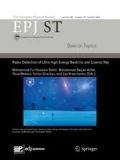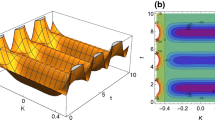Abstract
In this paper, Jacobi stability of a resonant nonlinear Schrödinger (RNS) system is studied by the KCC theory, which is also called differential geometric method. The RNS system is transformed into an equivalent planar differential system by traveling wave transformation, then the Lyapunov stability of equilibrium points of the planar system is analyzed. By constructing geometric invariants, we analyze and discuss the Jacobi stability of three equilibrium points. The results show that the zero point is always Jacobi stable, while the Jacobi stability of the other nonzero equilibrium points are determined by the values of the parameters. In addition, the focusing tendency towards trajectories around the equilibrium points are studied by the dynamical behavior of deviation vector. Finally, numerical results show that the system presents quasi-periodic and chaotic phenomena under periodic disturbances.









Similar content being viewed by others
Change history
13 January 2022
This article was revised due to wrong given names for two of the authors of reference 19 in the reference list.
References
E. Schrödinger, An undulatory theory of the mechanics of atoms and molecules. Phys. Rev. 28, 1049–1070 (1926)
G P. Agrawal, Nonlinear Fiber Optics 4th edn. San Diego, CA (1995)
A. Hasegawa, Y. Kodama, Solitons in Optical Communications (Oxford University Press, Oxford, 1995)
M. Eslami, M. Mirzazadeh, B. Fathi Vajargah, A. Biswas, The first integral method to study the resonant nonlinear Schrödinger’s equation with time-dependent coeffificients. Optik 125, 3107–3116 (2014)
H. Triki, T. Hayat, O.M. Aldossary, A. Biswas, Bright and dark solitons for the resonant nonlinear Schrödinger’s equation with time-dependent coeffificients. Opt. Laser Technol. 44, 2223–2231 (2012)
C. Chen, Y. Jiang, Z. Wang, J. Wu, Dynamical behavior and exact solutions for time-fractional nonlinear Schrödinger equation with parabolic law nonlinearity. Optik 222, 165331 (2020)
D.D. Kosambi, Parallelism and path-spaces. Math. Z. 37, 608–618 (1933)
E. Cartan, D.D. Kosambi, Observations sur le mémoireprécédent. Math. Z. 37, 619–622 (1933)
S.S. Chern, Sur la géométrie d’un systéme d’équations différentielles du second order. Bull. Sci. Math. 63, 206–212 (1939)
S.V. Sabau, Some remarks on Jacobi stability. Nonlinear Analysis: Theory, Methods with Applications 63, e143–e153 (2005)
C.G. Böhmer, T. Harko, S.V. Sabau, Jacobi stability analysis of dynamical systems applications in gravitation and cosmology. Adv. Theor. Math. Phys. 16, 1145–1196 (2012)
P.L. Antonelli, S.F. Rutz, V.S. Sabau, A transient-state analysis of Tyson’s model for the cell division cycle by means of kcc-theory. Open Systems with Information Dynamics 9, 223–238 (2002)
K. Yamasaki, T. Yajima, Lotka-Volterra system and KCC theory: Differential geometric structure of competitions and predations. Nonlinear Anal. Real World Appl. 14, 1845–1853 (2013)
K. Yamasaki, T. Yajima, Differential geometric structure of non-equilibrium dynamics in competition and predation: Finsler geometry and KCC theory. Journal of Dynamical Systems and Geometric Theories 14, 137–153 (2016)
K. Yamasaki, T. Yajima, KCC analysis of a one-dimensional system during catastrophic shift of the Hill function: Douglas tensor in the nonequilibrium region. Int. J. Bifurcat. Chaos 30, 13 (2020)
C.Y. Leung, C.S. Harko, T. Ho, S. Yip, Jacobi stability analysis of the Lorenz system. Int. J. Geom. Methods Modern Phys. 12, 55–72 (2015)
M.K. Gupta, C.K. Yadav, Jacobi stability analysis of Rossler system. Int. J. Bifurcat. Chaos 27, 63–76 (2017)
H. Abolghasem, Jacobi stability of Hamiltonian system. Int. J. Pure Appl. Math. 87, 18–194 (2013)
Q. Huang, A. Liu, Y. Liu, Jacobi stability analysis of Chen system. Int. J. Bifurcat. Chaos 29, 1950139 (2019)
Y. Liu, H. Chen, X. Lu, C. Feng, A. Liu, Homoclinic orbits and Jacobi stability on the orbits of Maxwell-Bloch system. Appl. Anal. pp 1–20 (2020)
A. Liu, B. Chen, Y. Wei, Jacobi analysis of a disc dynamo system. Int. J. Geometr. Methods Modern Phys. 17, 2050205 (2020)
C.G. Boehmer, T. Harko, S.V. Sabau, Jacobi stability analysis of dynamical systems applications in gravitation and cosmology. Adv. Theor. Math. Phys. 16, 1145–1196 (2012)
M. Kumar, T.N. Mishra, B. Tiwari, Stability analysis of Navier–Stokes system. Int. J. Geom. Methods Modern Phys. 16, 1950157 (2019)
M.K. Gupta, C.K. Yadav, Jacobi stability analysis of Rikitake system. Int. J. Geom. Methods Modern Phys. 13, 1650098 (2016)
O.K. Pashaev, J.H. Lee, Resonance solitons as black holes in Madelung fluid. Mod. Phys. Lett. A 17, 1601–1619 (2002)
W. Krolikowski, O. Bang, Solitons in nonlocal nonlinear media: exact solutions. Phys. Rev. E Stat. Nonlinear Soft Matter Phys. 63, 016610 (2001)
A. Biswas, S. Konar, Introduction to non-Kerr Law Optical Solitons (CRC Press, Boca Raton, 2006)
C. Udrişte, I.R. Nicola, Jacobi stability for geometric dynamics. J. Dyn. Syst. Geom. Theor. 5, 85–95 (2007)
S.V. Sabau, Systems biology and deviation curvature tensor. Nonlinear Anal. Real World Appl. 6, 563–587 (2005)
P. L. (ed.) Antonelli. Handbook of Finsler Geometry. Kluwer Academic, Dordrecht (2003)
M.A. Malkov, Spatial chaos in weakly dispersive and viscous media: A nonperturbative theory of the driven KdV-Burgers equation. Physica D 95, 62–80 (1996)
T. V. Laptyeva, J. D. Bodyfelt, D. O. Krimer, Ch. Skokos, S. Flach. The crossover from strong to weak chaos for nonlinear waves in disordered systems. EPL (Europhysics Letters), 91:30001(2010)
M. Mulansky, K. Ahnert, A. Pikovsky, D. L. Shepelyansky, Strong and weak chaos in weakly nonintegrable Many-Body Hamiltonian systems. J. Stat. Phys
D.M. Basko, Weak chaos in the disordered nonlinear Schrödinger chain: Destruction of Anderson localization by Arnold diffusion. Ann. Phys. 326, 1577–1655 (2011)
N.M. Ryskin, V.N. Titov. Transition to fully developed chaos in a system of two unidirectionally coupled backward-wave oscillators. Technical Physics
C.C. Lalescu, C. Meneveau, G.L. Eyink, Synchronization of chaos in fully developed turbulence. Phys. Rev. Lett. 110, 084102 (2013)
Acknowledgements
The authors thank the reviewers for their constructive and pertinent suggestions for improving the manuscript. This work is supported by the National Natural Science Foundation of China (Grant Nos. 11961074, 11971414), Natural Science Foundation of Guangxi Province (Grant No. 2018GXNSFDA281028), the Excellent Youth Foundation of SINOPEC (P20009), the High Level Innovation Team Program from Guangxi Higher Education Institutions of China (Document No. [2018] 35) and the research ability enhancement project of young and middle-aged teachers in Guangxi colleges and universities (Grant No. 2020KY14008).
Author information
Authors and Affiliations
Corresponding author
Rights and permissions
About this article
Cite this article
Lai, T., Feng, C., Liu, Y. et al. Geometric analysis and onset of chaos for the resonant nonlinear Schrödinger system. Eur. Phys. J. Spec. Top. 231, 2133–2142 (2022). https://doi.org/10.1140/epjs/s11734-021-00398-1
Received:
Accepted:
Published:
Issue Date:
DOI: https://doi.org/10.1140/epjs/s11734-021-00398-1




